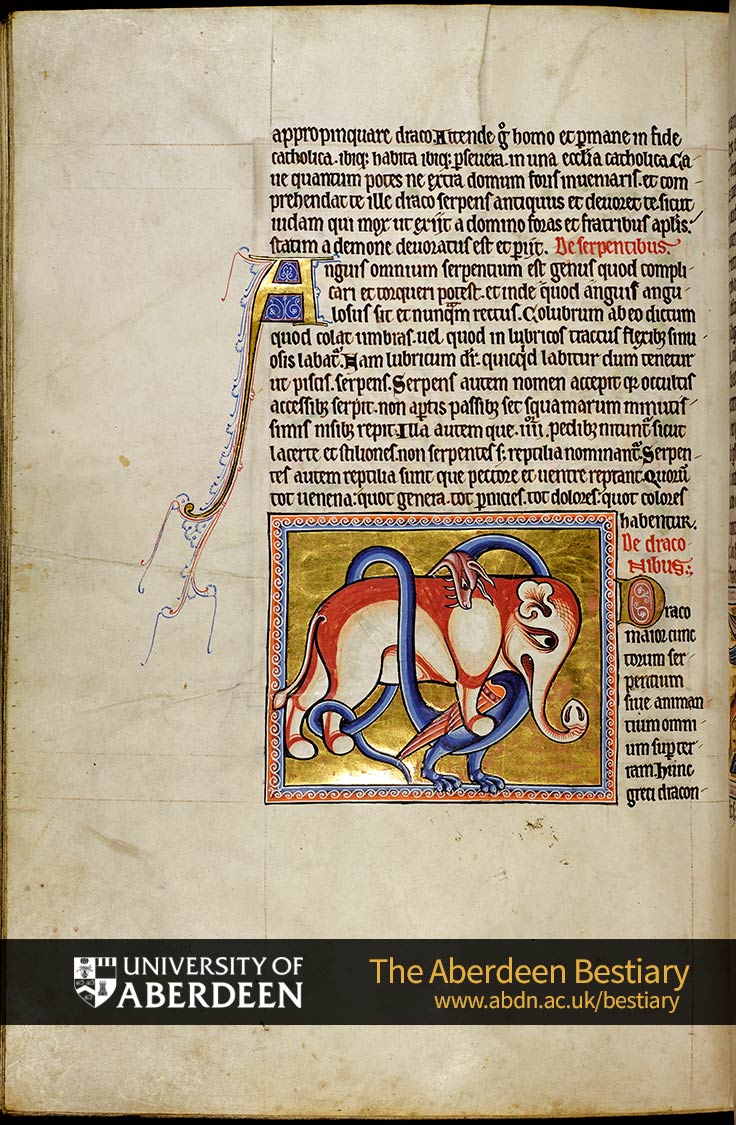Folio 65v - De serpentibus; Of snakes. De draconibus; Of the dragon.
cannot come near you. Take heed, therefore, O man, and stay within the catholic faith, live within it, remain steadfast within it, within the one catholic church. Be as careful as you can that you are not caught outside the doors of that house, that the dragon, the serpent of old, does not seize you and devour you, as Judas was at once devoured by the devil and perished, as soon as he had gone forth from the Lord and his brother apostles.
Of snakes
The word anguis is applied to the entire species of snake, because the snake's body can be folded and bent; as a result, it is called anguis because it forms a series of angles, angulosus, and is never straight.
The snake is also called coluber, either because it lives in the shadows, colere umbras, or because it wriggles along in a slippery way, in sinuous coils. For anything that slithers when you hold it, like a fish or a snake, is called lubricus, 'slippery'.
The snake gets its name, serpens, because it creeps up under cover, not by visible steps, but crawling along by the tiniest movements of its scales. Creatures which go on four feet, like lizards and newts are called not snakes but reptiles. Snakes are reptiles too, because they crawl, reptare, on their chests and bellies.
There are as many poisonous snakes as there are species; as many which bring death or suffering, as there are colours among them.
Of the dragon
The dragon is bigger than all other snakes or all other living things on earth. For this reason, the Greeks
- Commentary
-
Commentary
Text
Serpents. Many are poisonous. The dragon is bigger than all snakes.
Illustration
The dragon strangles an elephant. The text says the dragon has a crest, small mouth and does not kill with its teeth but with its tail. The illustrator has added massive teeth and wings. The description applies to an African python which can kill deer if not actually elephants by strangulation. Initials type 2.
Folio Attributes
- Transcription and Translation
-
Transcription
appropinquare draco. Attende ergo homo et permane in fide\ catholica, ibique habita ibique persevera, in una ecclesia catholica. Ca\ve quantum potes ne extra domum foris inveniaris, et com\prehendat te ille draco serpens antiquus et devoret te sicut\ Judam qui mox ut exiit a domino foras et fratribus apostolis\ statim a demone devoratus est et periit. \ De serpentibus \Anguis omnium serpentium est genus quod compli\cari et torqueri potest, et inde anguis quod angu\losus sit et nunquam rectus. Colubrum ab eo dictum\ quod colat umbras, vel quod in lubricos tractus flexibus sinu\osis labatur. Nam lubricum dicitur, quicquid labitur dum tenetur\ ut piscis, serpens. Serpens autem nomen accepit quia occultis\ accessibus serpit, non apertis passibus set squamarum minutis\ simis nisibus repit. Illa autem que quatuor pedibus nituntur sicut\ lacerte et stiliones, non serpentes sed reptilia nominantur. Serpen\tes autem reptilia sunt que pectore et ventre reptant. Quorum\ tot venena, quot genera, tot pernicies, tot dolores, quot colores\ habentur.\ De draconibus \Draco\ maior cunc\torum ser\pentium\ sive animan\tium omni\um super ter\ram. Hinc\ Greci dracon\Translation
cannot come near you. Take heed, therefore, O man, and stay within the catholic faith, live within it, remain steadfast within it, within the one catholic church. Be as careful as you can that you are not caught outside the doors of that house, that the dragon, the serpent of old, does not seize you and devour you, as Judas was at once devoured by the devil and perished, as soon as he had gone forth from the Lord and his brother apostles. Of snakes The word anguis is applied to the entire species of snake, because the snake's body can be folded and bent; as a result, it is called anguis because it forms a series of angles, angulosus, and is never straight. The snake is also called coluber, either because it lives in the shadows, colere umbras, or because it wriggles along in a slippery way, in sinuous coils. For anything that slithers when you hold it, like a fish or a snake, is called lubricus, 'slippery'. The snake gets its name, serpens, because it creeps up under cover, not by visible steps, but crawling along by the tiniest movements of its scales. Creatures which go on four feet, like lizards and newts are called not snakes but reptiles. Snakes are reptiles too, because they crawl, reptare, on their chests and bellies. There are as many poisonous snakes as there are species; as many which bring death or suffering, as there are colours among them. Of the dragon The dragon is bigger than all other snakes or all other living things on earth. For this reason, the Greeks

